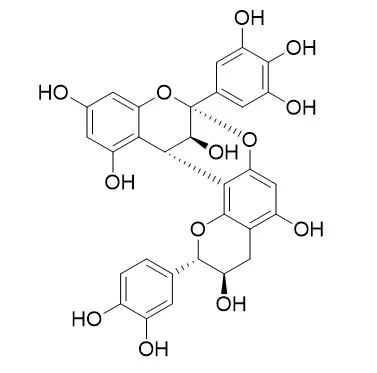| Structure Identification: |
| Molecules . 2013 May 6;18(5):5172-5189. | | A-type proanthocyanidins from the stems of Ephedra sinica (Ephedraceae) and their antimicrobial activities[Pubmed: 23648595] | | Phytochemical investigation of the n-BuOH-soluble fraction of the EtOH extract of the herbaceous stems of Ephedra sinica, which is known as Ephedrae Herba in Traditional Chinese Medicine, led to the isolation and identification of 12 A-type proanthocyanidins, containing five dimers, two trimers and five tetramers [i.e., (+)-epigallocatechin-(2α→O→7,4α→8)-(-)-catechin, named ephedrannin D₁, a dimer; epigallocatechin-(2α→O→7,4α→8)-epigallocatechin-(4α→8)-catechin (ephedrannin Tr₁), a trimer; and epigallocatechin-(2α→O→7,4α→8)-epigallocatechin-(4α→8)-epigallocatechin-(2α→O→7,4α→8)-gallocatechin, named ephedrannin Te1, a tetramer). Tetramers composed of gallocatechin are reported for the first time in Ephedraceae. Catechin, epicatechin, gallocatechin, epigallocatechin and four known dimers were also isolated. The structures were elucidated by extensive spectroscopic analysis. The absolute configurations of the 4α linkages, which were confirmed by NOESY and CD experiments, are the outstanding characteristic of most of these isolated A-type proanthocyanidins. The antimicrobial activities of these compounds were tested by measuring the minimum inhibitory concentrations (MIC) against bacteria (both Gram positive and Gram negative) and fungi, and were found to be in the range of 0.00515-1.38 mM. Compounds 6, 8, 10 and 11 exhibited moderate antimicrobial activities against Canidia albicans. |
|






 Cell. 2018 Jan 11;172(1-2):249-261.e12. doi: 10.1016/j.cell.2017.12.019.IF=36.216(2019)
Cell. 2018 Jan 11;172(1-2):249-261.e12. doi: 10.1016/j.cell.2017.12.019.IF=36.216(2019) Cell Metab. 2020 Mar 3;31(3):534-548.e5. doi: 10.1016/j.cmet.2020.01.002.IF=22.415(2019)
Cell Metab. 2020 Mar 3;31(3):534-548.e5. doi: 10.1016/j.cmet.2020.01.002.IF=22.415(2019) Mol Cell. 2017 Nov 16;68(4):673-685.e6. doi: 10.1016/j.molcel.2017.10.022.IF=14.548(2019)
Mol Cell. 2017 Nov 16;68(4):673-685.e6. doi: 10.1016/j.molcel.2017.10.022.IF=14.548(2019)